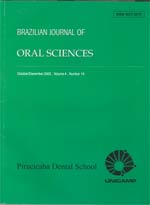
|
Brazilian Journal of Oral Sciences
Piracicaba Dental School - UNICAMP
EISSN:
Vol. 10, No. 2, 2011, pp. 140-145
|
 Bioline Code: os11028
Bioline Code: os11028
Full paper language: English
Document type: Research Article
Document available free of charge
|
|
|
Brazilian Journal of Oral Sciences, Vol. 10, No. 2, 2011, pp. 140-145
| en |
Association between infant feeding duration and the terminal relationships of the primary second molars
Nahás-Scocate, Ana Carla Raphaell; de Moura, Paulo Xavier; Marinho, Renata Bara; Alves, Adriana Pinheiro; Ferreira, Rívea Inês & Guimarães, Fernanda Meister
Abstract
Aim: This study was developed to assess the effect of prolonged bottle feeding and breastfeeding on the anteroposterior relationship of the dental arches in 3-6-year-old children attending preschools in the eastern zone of São Paulo city.
Methods: The association between infant feeding duration (artificial and natural) and occlusal characteristics were evaluated in 485 children at the stage of complete primary dentition, who attended municipal preschools in the eastern zone of São Paulo city. The information related to types and duration of child breastfeeding was investigated by means of questionnaires filled out by parents/guardians. The occlusal characteristics corresponding to the terminal relationships of the primary second molars were classified as vertical plane (VP), mesial step (MS) and distal step (DS). Logistic regression analysis (p < 0.05) was applied.
Results: Considering the right and left sides, DS was diagnosed in 9.7% of the cases, MS in 14.2% and VP in 76.1%, without significant differences between sides and genders. The association between the presence of DS and the age of bottle-feeding and breastfeeding cessation was significantly high (p < 0.001). The older the child when bottle-feeding ceased (34 years old) and the shorter the breastfeeding duration (<3 months), the greater the chances of the child presenting DS.
Conclusions: Breastfeeding duration is one of the factors that could influence the development of DS because the longer the breastfeeding duration, the higher the percentage of children who were not bottle fed, ranging from 5.8% (among children who interrupted breastfeeding before the age of 3 months) to 63.8% (after 12 months of age).
Keywords
bottle feeding, breastfeeding, malocclusion, epidemiology.
|
| |
© Copyright 2011 Braz J Oral Sci.
Alternative site location: http://www.fop.unicamp.br/brjorals
|
|
